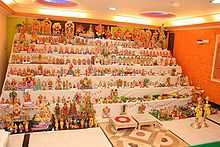Golu
| Kolu | |
|---|---|
 Display of Kolu in Tamil Nadu | |
| Also called | Navaratri Kolu |
| Observed by | Southern Indian Hindus |
| Type | Hindu |
| Celebrations | Saraswati Pooja, Rangoli |
| Begins | Mahalaya |
| Ends | Vijayadasmi |
| 2014 date | |
| Related to | Navratri |
Golu or Kolu or Bombe Habba (Kannada) or Bommai Kolu (Tamil) or Bommala Koluvu (Telugu) is a toy festival celebrated during the festival of Navratri in Southern India, it is customary in the states of Tamil Nadu, Kerala, Andhra Pradesh and Karnataka, as well as in some Tamil communities within Sri Lanka, to display.[1] This is an exhibition of various dolls and figurines in odd (usually 7, 9, or 11) numbered tiers (padis).
Etymology
Kolu or Golu in Tamil (கொலு) means Divine Presence. Bommala Koluvu (బొమ్మల కొలువు) in Telugu means Court of Toys. Kolu/Bommala Koluvu represents the divine presence of the Goddesses Saraswati, Parvati and Laxmi in the Kannada ,Telugu and Tamil households during Navaratri (Nine nights).
Customs
When people come to a person's house to see the Kolu, usually they are given prasad (the offering given to God that day), kumkum and a small bag of gifts. These are only given to girls and married women. In the evenings, a "kuthuvilakku" (small lamp) is lit, in the middle of a decorated "kolam"(Rangoli), before the Kolu and devotional hymns and shlokas are chanted. After performing the puja, the food items that have been prepared are offered to the goddesses.

Kolu is adorned with dolls – predominantly with that of the gods and goddesses depicting mythology. It is a traditional practice to have at least some wooden dolls. There should also be a figurine of a boy and a girl together called 'Marapacchi' Bommai.[2]
On the 9th day (Saraswati Puja), special pujas are offered to Goddess Saraswati – the divine source of wisdom and enlightenment. Books and musical instruments are placed in the puja and worshipped as a source of knowledge. Also, tools are placed in the pooja as part of "Ayudha Pooja". Vehicles are washed and decorated, and puja is performed for them.
The 10th day, "Vijayadasami" – is the most auspicious day of all. It was the day on which evil was finally destroyed by good. It marks a new and prosperous beginning. New ventures started on this day are believed to flourish and bring prosperity. Kids often start tutoring on this day to have a head start in their education.
In the evening of "Vijayadasami", any one doll from the "Kolu" is symbolically put to sleep and the Kalasam is moved a bit towards North to mark the end of that year's Navaratri Kolu. Prayers are offered to thank God for the successful completion of that year's Kolu and with a hope of a successful one the next year. Then the Kolu is dismantled and packed up for the next year.

Significance
Like any festival, Kolu also has a significant connection with agricultural economy of ancient India. It is said that in order to encourage dredging and de-silting of irrigation canals and riverbeds the Kolu celebration was aimed at providing demand for the clay material got from such activities. There are many peculiar customs and beliefs in different parts of India that imbue sacred status to clay. Dissolving Ganesha dolls made of wet clay into the water system is one such belief. Another example is the Bengali tradition of using clay that has been tread upon by the most beautiful girl in the area to construct a doll of the Goddess Kali, the belief being that this would be the best way to approximate the perfect features of the Goddess.
See also
- Hinamatsuri in Japan
References
External links
- Symbolism of Kolu - http://veda.sakthifoundation.org/golu.htm
- Navratri Dandiya Events 2013 in USA - http://mycity.sulekha.com/navratri-dandiya_events-tickets
Gallery
| Wikimedia Commons has media related to Golu. |
-

Golu
-

Display of the Navratri Golu in seven steps in Tamil Nadu
-
Navratri Golu in Tamil Nadu
-

Display of the Navratri Golu depicting Dashavatara
-

Display of the Navratri Golu Cartoon characters (these are acceptable dolls in a Kolu, and may even sit next to traditional Indian dolls)
-

Display of the Navratri Golu some more Cartoon characters
-

Display of the Navratri Golu Bharatanatiyam dancer in traditional costume
-

Display of the Navratri Golu Krishna in the childhood avatar
-

Display of the Navratri Golu Peacock made of soft wood from Kondapalli near Vijayawada, India
-

Display of the Navratri Golu Poikalkutirai – Traditional dancer during temple festivals in India
-

Display of the Navratri Golu Murugan along with Valli and Deivanai
-

Display of the Navratri Golu Cartoon characters
-

Display of the Navratri Golu Yanaimel Ambari
-

Collage of the display of the Navratri Bombegalu in Walldorf, Germany



